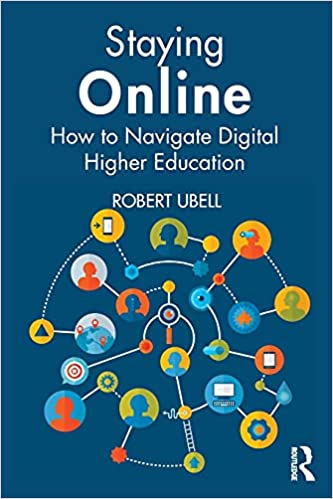You have /5 articles left.
Sign up for a free account or log in.
 Staying Online: How to Navigate Digital Higher Education by Robert Ubell
Staying Online: How to Navigate Digital Higher Education by Robert Ubell
Published in September 2021
I grew up in an academic family. My dad was a professor. Many of the adults in my life were academics. Some of these academics also taught at my dad’s university. But most were my dad’s colleagues from other schools. They would come to visit him on campus or at our home, or we would see them at conferences. (Dad would frequently combine family and professional travel.)
My childhood and teenage years gave me an appreciation of the value of an academic community. An understanding that colleagues and friends can be the same people. And that academia encourages these friendships to be developed with colleagues both nearby and faraway.
Over the past 15 years or so, Bob Ubell has been one of the “faraway” colleagues I’ve most valued. As I found my voice as a writer on higher education, Bob has always been a source of encouragement and wisdom. He is the sort of person to reach out with a short note of congratulation and praise. Over my career, I’ve continuously looked to Bob to help me make sense of the role of online learning in the broader higher education story.
For all these reasons, I am so happy to share with you how thrilled I was to read Bob’s latest book, Staying Online: How to Navigate Digital Higher Education.
Staying Online is Bob in book form. The book is wise, smart, funny, modest, direct, personal, insightful and easy to spend time with.
Staying Online provides a timely analysis of the major challenges and trends related to online, blended and digital learning. The book contextualizes these trends within the story of how universities are navigating the pandemic.
The book draws a series of insightful lessons from the history of online education, and the recent developments around COVID-19 and remote learning, to chart a progressive and optimistic path for teaching and learning at our nation’s colleges and universities.
In a concise and fast-moving 158 pages, Staying Online covers a great deal of territory. Starting with what colleges and universities have learned while attempting to maintain academic continuity during the pandemic, the book moves on to cover a range of issues and trends related to online learning.
In a series of short chapters, the book highlights the core ideas of learning science that underpin course design and effective instruction. Issues relating to organizational structures and institutional investments to advance the quality and scale of online programs are covered.
The pros and cons of nonprofit colleges and universities collaborating with for-profit companies (OPMs and platforms) in funding, developing and running online degrees are also investigated in Staying Online.
What I very much like about Staying Online is how Bob weaves his analysis of the present and future of online learning into his career journey. Bob is unafraid to talk about times where he was unsure of his abilities as an academic -- such as in retelling his own online teaching story. His experience working with an instructional designer and a team of nonfaculty educators to create an online course is one of the best examples I’ve read about the educator development benefits of teaching online.
In a chapter about scaled online education, Bob talks about his original misgivings about MOOCs -- and how his ideas have changed as he has watched (and participated) in the evolution of online learning. Through a long career as an educator and leader in the online learning space, and as a scholar and student of higher education change, Bob is well positioned to provide our community with actionable insights.
Staying Online can be read as a call for colleges and universities to place online learning on an equal footing with residential learning in developing long-term institutional strategies.
Both skeptics and champions of online learning would benefit from spending time with Bob and from reading Staying Online.
What are you reading?




